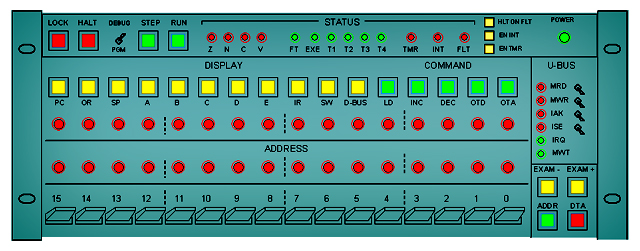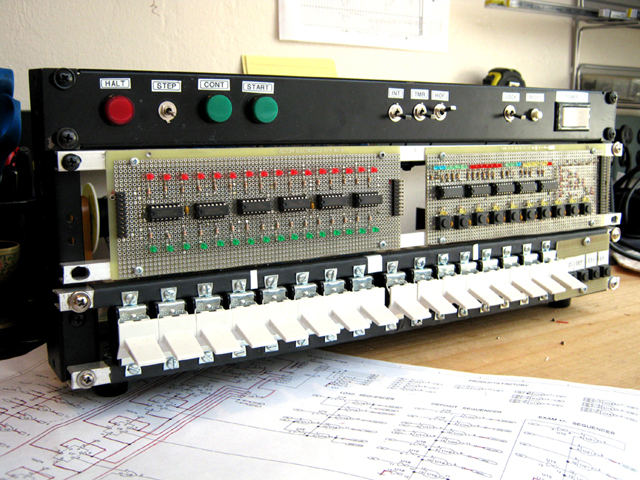The ProjectThis project is about designing and building Heritage/1, an old-fashioned homebrew minicomputer similar to those in the latest 60's and early 70's. Official start date is 05/13/2009. Completion is expected within one or two years from the starting date.
A love story
While searching the Internet for "relay computers" in May 2009, I discovered the world of "Homebrew CPUs" and got fascinated with the idea. Determined to build my own old-fashioned minicomputer, I commenced to study existing projects as well as building, little by little, a basic background on computer design and OS development.
One month later I had a total mess of ideas and a loved creature called: the "Heritage/1" homebrew minicomputer. Soon I realized that the project was too complex for a first try so I decided to put it on hold while devoted my efforts to a simpler "pre-project" that I called "PREHER/816". This would be a simple 8 bits machine resembling the architecture of a Z80 microprocessor; the purpose was then to gain the necessary experience for tackling the "main project" (Heritage/1) in a second step.
However, the ideas developed during the "pre-project" resulted interesting enough to me so I started to fall in love with the new computer up to the point that I decided to make her the main subject of my project and that's how she inherited the name reserved for the previous one: Heritage/1. Eventually the project evolved into an even simpler machine based on a quasi-ortogonal 16-bits architecture pretty much inspired by John Doran's D16/M minicomputer.
As a result of all this going back and forward, you will see mixed names in this web site. For now, Heritage/1 refers to the current machine being designed.
Heritage/1 is now meant to be simple and fast (as fast possible for the old technology it employs) and it is for the sake of speed that microcoding has been discarded at once and data transfer is being engineered so it takes the shorter path possible.
So Heritage/1 is (or will be) a simple 16 bits home-brew minicomputer and it is that (simplicity) the most loved feature that I find in the design being developed.
What can we expect from Heritage/1?
Heritage/1 is expected to resemble a minicomputer similar to those of the 1970's. It won't feature the nowdays familiar video monitor, keyboard and mouse but the "clasical" switches and lamps (LEDs) on the prominent Control Panel.
At the beginning there will no Operating System so the machine will be some kind of laboratory for experimenting with low level software. Storage will appear at some point; I wish to employ magnetic tapes but that would be tremendously expensive, so must likely it will an IDE hard drive, a Floppy Drive or something similar.
Hopefully a "Monitor" program (a rudimentary operating system) will be developed at some point in history so users will finally be able to run "useful" programs. Users will access the computer from PCs running terminal emulation applications such as Hyper Terminal, connected via RS232 ports. They will also be able to connect remotely through the telephone line via modems as in the old days.
As per applications, I am not thinking in word processors or spread sheets, but Mathematics oriented programs most likely running in a batch-processing fashion. Database applications are also feasible.
Multi-tasking and multi-users, that is, a "real" operating system is far away if ever happens at all. Nevertheless, Heritage/1 is open to any kind of software experiments with the advantage of having a hardware very well known up to the last screws and nuts.
Project Status
12/01/2010:
This project can be traced back to May 2009 but it actually started to take shape on July 2009 when I adopted the 16-bits double-buffer architecture that finally survived. That was one year and five months ago. More that one thousand dollars have been spent since then in components, connectors and prototyping boards... very expensive stuff for a poor individual such as my self!
Most of the circuits have been drawn, some have been built and tested and a mountain of ideas about system software and applications has grown little by little, but only on paper because there is not way for testing them until the hardware is ready. An assembler (H1ASM) and a simulator (H1SIM) were developed in Borland Turbo Pascal 3 using an old MS-DOS PC.
What I was trying to build is a "lab implementation" of the CPU. The Console and most of their support boards were built and tested. The project was going well but slowly... very slowly: estimates showed me that it would take another year (at least) for completion.
On 10/13/2010 I made the difficult decision to put the project to sleep until I could find enough spare time in my busy life. I then started a simpler project termed LC-81, based on Zilog Z80 microprocessor instead of discrete logic.
I've started to post notes in the following site:
http://www.armandoacosta.com/lc81
|


